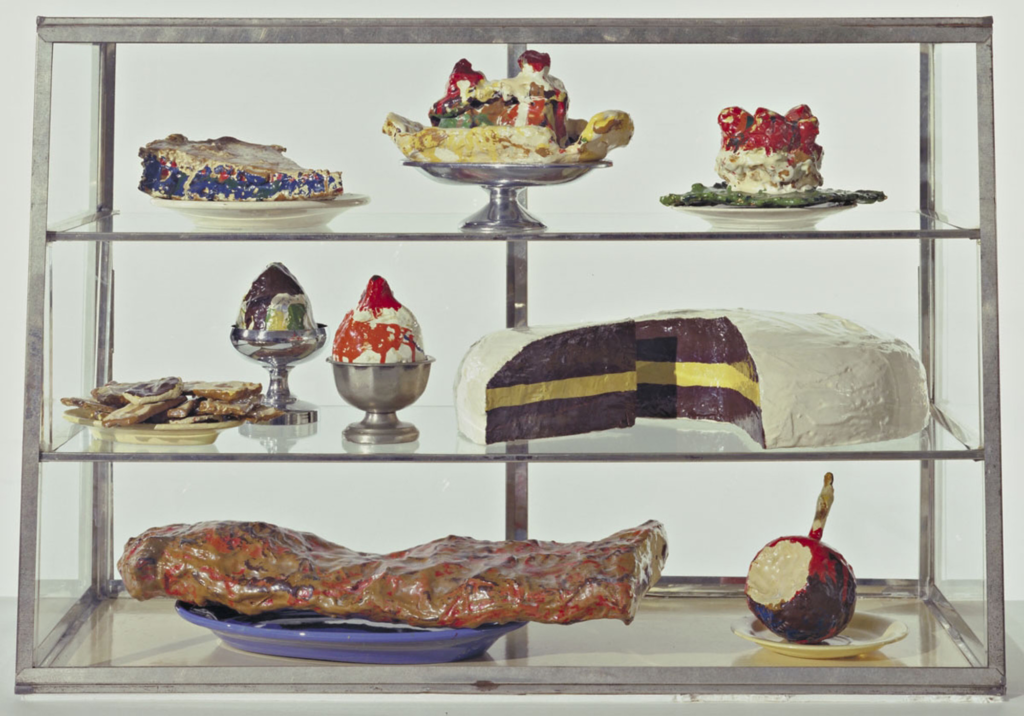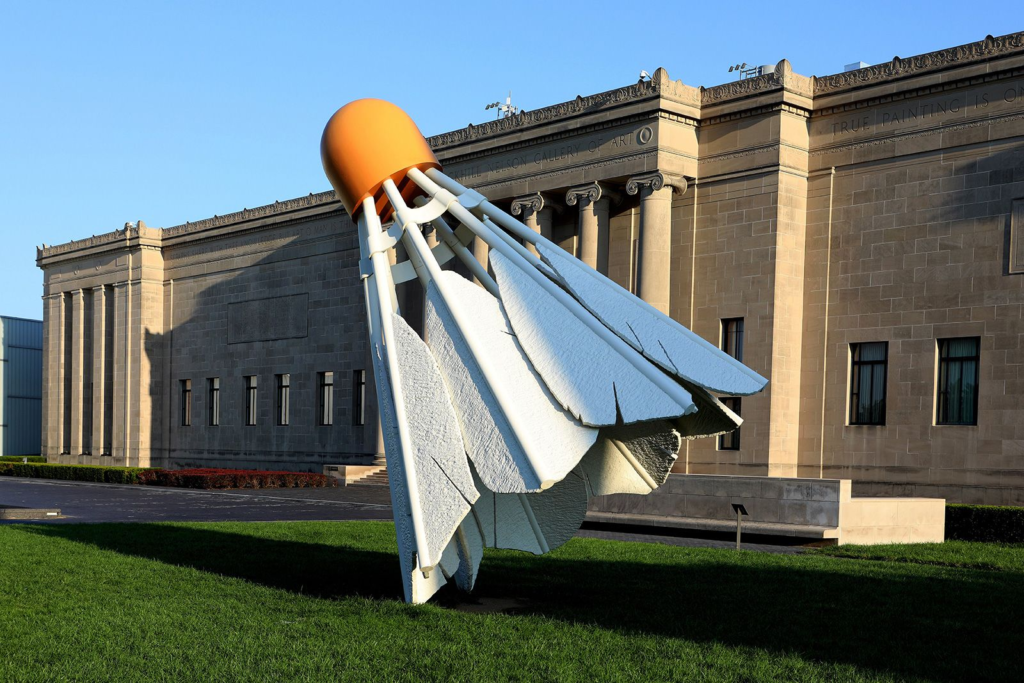CLAES OLDENBURG BIOGRAPHY

Early Life and Education
Born on January 28, 1929, in Stockholm, Claes Oldenburg was destined to become a trailblazer in art. However, his artistic journey began much later in life. At age five, he and his family relocated to Chicago, where he would spend his formative years.
Oldenburg’s creative spark ignited during his studies at Yale University and the Art Institute of Chicago. Here, he explored various mediums and honed his skills as an artist. His early works showcased a fascination with everyday objects and a desire to challenge societal norms through art.
After completing his education, Oldenburg moved to New York City in 1956 – a city teeming with energy and artistic enthusiasm. This vibrant backdrop was the perfect playground for him to experiment with unconventional materials such as plaster and burlap.
As Oldenburg delved deeper into his craft, he developed an artistic style characterized by Pop Art influences combined with elements of Surrealism. He sought inspiration from mundane objects like typewriters or hamburgers but transformed them into larger-than-life sculptures that challenged our perception of reality.
What is CLAES OLDENBURG known for?

Claes Oldenburg is best known for his contributions to the Pop Art movement. He is famous for creating large-scale sculptures of everyday objects, such as hamburgers, typewriters, and clothespins. Oldenburg’s sculptures are often playful and whimsical, challenging traditional notions of art and blurring the line between high and low culture.
His work has been exhibited in museums worldwide and has significantly impacted contemporary art. In addition to his sculptures, Oldenburg has also worked in other mediums, including painting and drawing.
Career highlights

When did Claes Oldenburg start making art?
Claes Oldenburg’s career began in the late 1950s when he moved to New York City, a hub of artistic innovation. Here, he found his artistic style and became a crucial figure in the pop art movement.
Artistic Style
His use of everyday objects characterizes Oldenburg’s artistic style as inspiration for his sculptures and installations. He often takes ordinary items such as hamburgers, typewriters, and telephones, transforming them into oversized sculptures that challenge our perceptions of scale and function.
Claes Oldenburg’s career beginning marked an exciting time for him as an artist finding himself amidst other creative minds in New York City. His unique artistic style continues to captivate audiences today through his playful subversion of everyday objects.
How did Claes Oldenburg make art?
Oldenburg’s art is characterized by its playful and humorous nature, often transforming ordinary objects into exaggerated and surreal forms. He found inspiration in the world around him, drawing from everyday things like hamburgers, typewriters, and clothespins.
To create his sculptures, Oldenburg would first make small models or maquettes. These models would then be enlarged and fabricated into larger structures using materials such as fiberglass or steel. The final sculptures would often be painted in bright, vibrant colors to emphasize their whimsical nature further.
Throughout his career, Claes Oldenburg has continued pushing traditional sculpture’s boundaries, creating iconic works that challenge our perceptions of art and everyday objects. His unique approach and innovative techniques have made him a prominent figure in the art world.
Who inspired Oldenburg?
Claes Oldenburg, a renowned pop artist, drew inspiration from various sources throughout his career. One of his primary influences was the Dada movement, which rejected traditional artistic conventions and embraced absurdity and randomness.
Oldenburg was particularly inspired by Marcel Duchamp, a key figure in the Dada movement, who challenged the very definition of art with his readymades. Oldenburg admired Duchamp’s ability to transform everyday objects into art and incorporated this approach into his work.
The consumer tradition of the 1950s and 1960s also influenced Oldenburg. He found inspiration in the mass-produced objects and advertisements that surrounded him, and he sought to bring these objects into the realm of art.
By creating large-scale sculptures of everyday items like hamburgers, typewriters, and clothespins, Oldenburg challenged the notion of what could be considered art and encouraged viewers to reevaluate their understanding of the world around them.
In addition to these influences, Oldenburg was also inspired by the happenings and performance art of the 1960s. He collaborated with other artists, musicians, and dancers to create immersive experiences that blurred the lines between art and life.
These performances often featured oversized sculptures and unconventional materials, further emphasizing Oldenburg’s interest in challenging traditional artistic boundaries.
CLAES OLDENBURG List of Work

What is Claes Oldenburg art style?
Modern Art
Pop Art
Throughout the 1960s and beyond, Oldenburg’s reputation grew alongside an impressive body of work.
1961 | The Store | It recreated a cluttered shop filled with whimsical objects made out of papier-mâché. |
1967 | Giant Soft Fan | This larger-than-life fan, made from soft vinyl, hangs from the ceiling, appearing limp and lifeless. The contrast between the familiar object and its unexpected material creates a playfulness and invites viewers to question their assumptions about what art can be. |
1970 | Claes Oldenburg: Object into Monument | He had a solo exhibition at MoMA in New York City titled “Claes Oldenburg: Object into Monument.” This retrospective showcased his most famous pieces and solidified his place in art history. |
Accolades
In recognition of his contributions to contemporary art, Claes Oldenburg has received numerous accolades throughout his career. In 1995, he was given the National Medal of Arts by Bill Clinton for his significant impact on American culture through bold experimentation with form and subject matter.
Exhibitions
Oldenburg’s groundbreaking contributions have earned him numerous accolades throughout his career, including being awarded grants from prestigious institutions like The National Endowment for the Arts, exhibition opportunities at renowned museums such as The Museum of Modern Art (MoMA) in New York City, and even representation by esteemed galleries worldwide.
Why did Oldenburg make soft sculptures?
Oldenburg made soft sculptures to challenge traditional notions of art and sculpture. He wanted to create works that were playful, unexpected, and accessible to a broad audience. By using soft materials like fabric and foam, Oldenburg created sculptures that were more approachable and less intimidating than traditional, intricate ones. He also wanted to explore art as something that could be touched and interacted with rather than just observed from a distance.
What technique does Oldenburg use?
In terms of technique, Oldenburg used various methods to create his soft sculptures. He often began by making a small model or sketch of the statue, which he would then use as a guide for constructing the final piece. He then cut and sewed fabric or foam together, usually using a sewing machine, to create the desired shape and form.
Oldenburg also sometimes incorporated found objects or everyday items into his sculptures, adding an element of surprise and humor to the finished piece. His technique combined traditional sewing and sculptural methods to create his unique soft sculptures.
